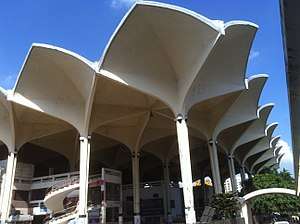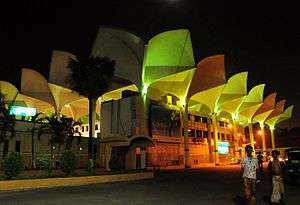Kamalapur railway station
Dhaka Railway Station, Dhaka, Bangladesh (Dhaka Kamalapur) ঢাকা রেলস্টেশন | |
|---|---|
| Bangladesh Railway Station | |
 Kamalapur Railway Station, Dhaka | |
| Location |
Dhaka Bangladesh |
| Coordinates | 23°43′55″N 90°25′34″E / 23.7320°N 90.4262°ECoordinates: 23°43′55″N 90°25′34″E / 23.7320°N 90.4262°E |
| Line(s) | Narayanganj–Bahadurabad Ghat line |
| Platforms | 8 |
| Construction | |
| Structure type | Standard (on ground station) |
| Other information | |
| Status | Functioning |
| History | |
| Opened | January 1969 |
Kamalapur Railway Station is the central railway station in Dhaka, Bangladesh. The station is the largest in the country and the most important terminal for transportation between Dhaka and the rest of Bangladesh. It is also one of the most modern and striking buildings in Dhaka designed by American architect Robert Boughey. The railway station situated in the north-east side of Motijheel, was established in the early 1960s and started its operation from 1969.[1]
History
There was only one railway station in Fulbaria. After the partition of Bengal, Dhaka became an important city and Kamalapur was selected for extension. Prior to the station being constructed, the land was a paddy field. At the beginning of the 1960s the station was built, and at that time it was one of the most important establishments in East Pakistan. It was mesmerizing to people at that time as there were not many beautiful structures in Dhaka.
Architectural value
Kamalapur Railway Station was built by Robert Boughey, and the station reflects his own way of style. The station is an architectural marvel, with a lotus-shaped shell structure covering functional buildings like an umbrella, thus unifying all various spaced beneath it. Boughey was one of the five American professors of architecture, who taught at the Bangladesh University of Engineering and Technology, when the university begun the program in 1962.
The station contains 21 ticket counters, and local tickers can be bought from 20 ticket counters. Tickets are available to go to India. There are two vudas, one for first class, and the other for second class passengers. The station has eight platforms and there are two restaurants in front of the ticket counters. There are also fast food shops near the ticket counters.
Present condition
There are 47 local trains, 40 mail/ express trains and 30 inter-city trains going through the station. The station has many security guards, station masters, along with one station manager. Every day, thousands of people come through the station. The trains go to many parts of Bangladesh such as-Rajshahi, Khulna, Chittagong, Sylhet, Rangpur, Dinajpur etc. The platforms are always populated. There are lots of police and guards inside and outside of the station to control the area. The station is sometimes used as a sleeping place for homeless people.
Gallery
 Kamalapur Railway Station
Kamalapur Railway Station Platform 3
Platform 3 Kamalapur Railway Station at night
Kamalapur Railway Station at night Sonar Bangla Train
Sonar Bangla Train
See also
References
Further reading
- Rahman, Mahbubur (2012). "Architecture". In Islam, Sirajul; Jamal, Ahmed A. Banglapedia: National Encyclopedia of Bangladesh (Second ed.). Asiatic Society of Bangladesh.
- James-Chakraborty, Kathleen (2014). "Reinforced concrete in Louis Kahn's National Assembly, Dhaka: Modernity and modernism in Bangladeshi architecture". Frontiers of Architectural Research. 3: 81–88. doi:10.1016/j.foar.2014.01.003.
External links
![]()